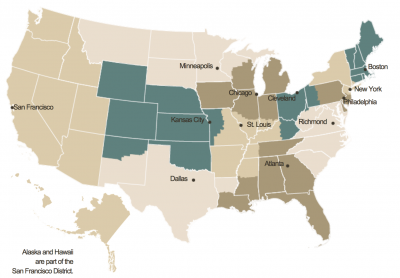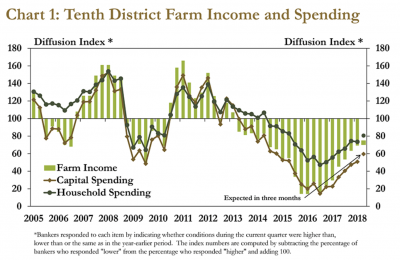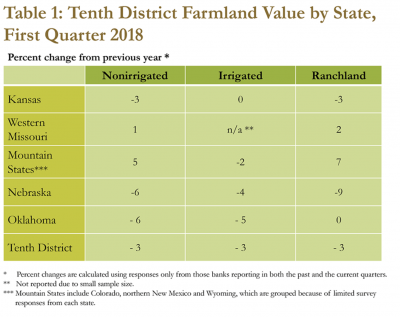Beef prices are projected to continue increasing as U.S. beef production declines with no signs of a cattle herd rebuild. Additionally, cheap beef may soon become further out of reach…
Federal Reserve: Observations on the Ag Economy- May ’18
On Wednesday, the Federal Reserve Board released its May 2018 Beige Book update, a summary of commentary on current economic conditions by Federal Reserve District. The report included several observations pertaining to the U.S. agricultural economy.

* Sixth District- Atlanta– “Agriculture conditions across the District were mixed. Drought conditions abated in parts of Alabama and Georgia but deteriorated slightly in south Florida. May’s forecast for Florida’s orange crops was down from April. On a year-over-year basis, prices paid to farmers in March were up for corn, rice, soybeans, broilers, and eggs, flat for beef, and down for cotton.”
* Seventh District- Chicago– “The outlook for farm income for 2018 brightened again, with improvements concentrated in the crop sector.
Nonetheless, several contacts expressed unease over the potential impact of international trade policies on the farming sector.
“After weather-related delays, corn and soybean planting proceeded quickly in Illinois and Indiana, to the point that it was running ahead of normal progress.
#Illinois #soybean planting nearly complete. 90% planted as of May 27, 60% one year ago, and 62% for the five-year average. #plant18 #agchat @ILAgriculture @usda_nass. Full report at: https://t.co/t4iwk1xJdT pic.twitter.com/oTMa418oU5
— Farm Policy (@FarmPolicy) May 29, 2018
“However, Iowa and Wisconsin were somewhat behind their typical paces for planting. Corn prices rose during the reporting period, while soybean prices drifted down.
The average price received by #farmers for #corn during April in #Iowa was $3.52 per bushel. This was up $0.09 from the March price and $0.18 above a year ago @usda_nass pic.twitter.com/nezpF1IYMH
— Farm Policy (@FarmPolicy) May 30, 2018
“Dry weather and the late spring hindered the development of pastures, which led to shortages of and higher prices for hay, cutting into margins for some livestock producers. Cattle and egg prices were down, but hog and dairy prices moved up. Dairy prices were still quite low, however, and there were reports of a bump up in operators exiting the sector.”
* Eighth District- St. Louis– “District agriculture conditions improved modestly from the previous reporting period and robustly from the same time last year. After contacts reported concerns about weather being too wet and cold for a strong early planting season, mid-May planned acreage planted for corn, cotton, and soybeans were, respectively, 13, 12, and 24 percentage points above the same time last year. Rice planting progress was slightly behind 2017. Contacts indicated that the prospective Chinese tariffs on U.S. soybeans would be damaging to exporters but at this point seemed unlikely.”
* Ninth District- Minneapolis– “District agricultural conditions were mixed.
While recent increases in some commodity prices were viewed as a positive sign, farmers were also concerned about access to international markets.
“Late-season snows delayed spring planting in much of the District, with crop progress well behind five-year averages as of mid-May.”
* Tenth District- Kansas City– “The Tenth District farm economy continued to weaken but the pace of deterioration slowed due to a slight uptick in agricultural commodity prices. Prices for all major agricultural commodities in the District increased slightly during the survey period. Despite the increase in prices, farm income continued to decline and demand for financing remained high.

“Bankers generally expect the pace of loan demand to increase in coming months and continued to report increased interest rates on all types of agricultural loans, which could raise interest expenses for farm borrowers. However, farmland values remained relatively stable and loan delinquency rates remained low. District contacts expressed concern about liquidity in the farm sector due to further income declines, but the relative stability of farmland values provided ongoing support for both producers and lenders.”

* Eleventh District- Dallas– “Drought conditions continued to plague much of West Texas and Southern New Mexico, particularly in the Texas panhandle. Crop conditions for winter wheat were much poorer compared with last year due to the lack of soil moisture.

“Row crop planting continued and crops were in mostly fair to good condition, but there was concern among producers about the dry weather potentially causing below-average yields. Given the current level of prices, grain farmers need at least average yields to be profitable this year. Cotton farmers were a bit more optimistic due to higher prices over the last six weeks and because cotton yields generally hold up better than other crops during drought. Cattle prices rose, largely due to seasonal factors but also buoyed by very strong domestic and international demand.”
* Twelfth District- San Francisco– “Conditions in the agriculture sector deteriorated somewhat. Current inventories and yield expectations for a variety of crops fell because of lower-than-expected precipitation levels in much of the District over the past few months.”





